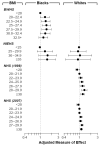New directions in the epidemiology of uterine fibroids
- PMID: 20414843
- PMCID: PMC5330647
- DOI: 10.1055/s-0030-1251477
New directions in the epidemiology of uterine fibroids
Abstract
Although uterine leiomyomata (fibroids) have been the leading indication for hysterectomy in the United States for decades, the epidemiological data on fibroid prevalence and risk factors are limited. Given the hormonal dependence of fibroids, most earlier studies focused on reproductive or hormonal factors. Recent analyses have extended that focus to other areas. We present previously unpublished data on the association between reproductive tract infections and fibroids that highlight the need for more detailed studies. Our review suggests that metabolic, dietary, stress, and environmental factors may also play a role in fibroid development.
Published in 2010 by Thieme Medical Publishers.
Figures


References
-
- Stewart EA. Uterine fibroids. Lancet. 2001;357(9252):293–298. - PubMed
-
- Farquhar CM, Steiner CA. Hysterectomy rates in the United States 1990-1997. Obstetrics and gynecology. 2002;99(2):229–234. - PubMed
-
- Flynn M, Jamison M, Datta S, Myers E. Health care resource use for uterine fibroid tumors in the United States. American journal of obstetrics and gynecology. 2006;195(4):955–964. - PubMed
Publication types
MeSH terms
Substances
Grants and funding
LinkOut - more resources
Full Text Sources
Other Literature Sources
Medical

